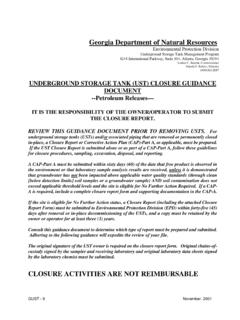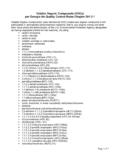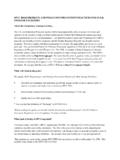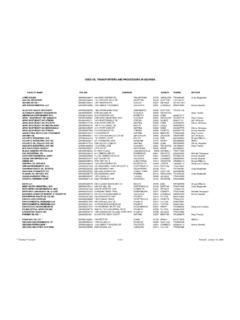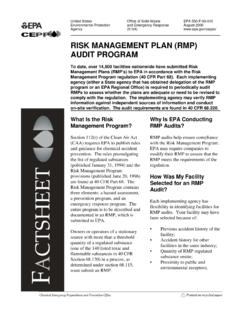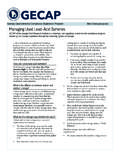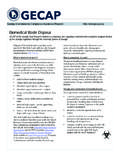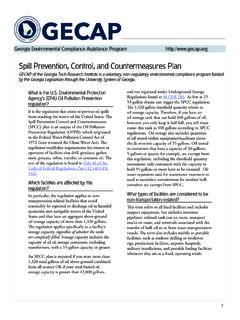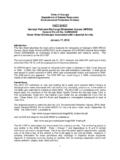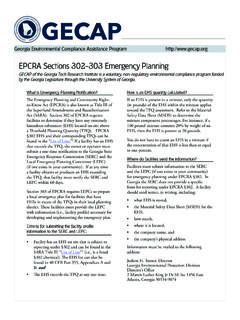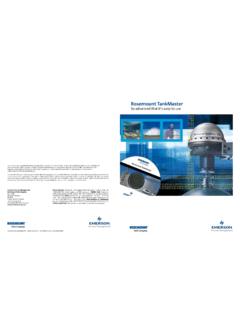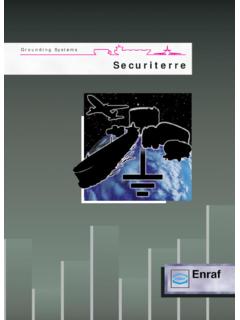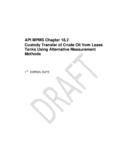Transcription of GECAP
1 Georgia Environmental Compliance Assistance Program Underground Storage TanksGECAP of the Georgia Tech Research Institute is a voluntary, non-regulatory environmental compliance program funded by the Georgia Legislature through the University System of I need to register my Underground Storage Tank (UST)?Yes. Your UST system can be installed without preapproval from or registration with the Georgia Environmental Protection Division (EPD); how-ever, it must be registered with the EPD prior to filling and operating the UST system. To register a UST in Georgia you need to complete and submit the EPD Notification Data for Underground Stor-age Tank form (form GUST-42). The GUST-42 form is available under the Forms link on the EPD website ( ) or or by calling form should be sent to:EPD USTMP 4244 International Parkway Suite 104 Atlanta GA 30354In response to the GUST-42, the EPD will issue an Annual UST Registration Certificate.
2 Once the certificate is obtained, the UST system can be filled and put into operation. The GUST-42 form must be submitted annually and when any UST system modifications are made. What regulations apply to UST systems?All UST systems must have release detection, spill and overfill prevention, and corrosion Detection Federal regulations (40 CFR Part 280 Subpart D) require owners and/or operators (O/O) to have release detection for both tanks and piping. Ex-isting UST Systems (those installed on or before December 22, 1988) were required to implement a release detection method by December 22, 1993. New UST Systems (those installed after December 22, 1988) are required to implement a release detection upon Release DetectionThere are two categories of tank release detection: inventory control and monthly control must be used in conjunction with tightness testing.
3 This method can be used for ten years after a tank has been installed or upgraded with corrosion protection, whichever is later. Inventory must be collected daily and reconciled monthly. A tightness test must be performed every five years after the tank has been upgraded or installed with corrosion protection. After the ten-year period, the O/O must change to a monthly monitoring method to comply with the tank release detection a monthly monitoring method to meet the tank release detection requirements includes check-ing the tank for leaks at least once a month using one or a combination of the following methods: Manual Tank Gauging (this method can be used as the sole method of leak detection for the life of the tank for tanks with a capacity of 550 gallons or less. It can also be used in combination with tank tightness testing for 10 years after the tank was upgraded or installed with corrosion protec-tion for tanks 2,000 gallons in capacity or less); Vapor Monitoring; Groundwater Monitoring; Automatic Tank Gauging (ATG); Interstitial Monitoring; and/or Statistical Inventory Reconciliation (SIR).
4 Each monthly monitoring method has specific re-quirements and/or limitations that must be consid-GECAP1five years thereafter), or installing an impressed current system on the bare steel tank and UST System installed after December 22, 1988 ( New UST System) must be a cathodically protected steel tank (Sti-P3 ) or be composed of a non-corrodible material, such as fiberglass-rein-forced plastic (FRP).What do I do if my tanks do not meet the upgrade requirements?All UST Systems must have release detection (1993), spill and overfill prevention (1998), and corrosion protection (1998). If you have a UST System that does not contain corrosion protection, it should be closed immediately. If you have a UST System that is upgraded and the system is empty, the corrosion protection must be maintained. If you have a UST System that is upgraded and the system contains product, release detection require-ments must be continuously should I do if I discover that my UST System is leaking?
5 A suspected release should be reported to the EPD UST Management Program (USTMP; 404-362-2687) within 24 hours. A tightness test and/or site check should be conducted to confirm or resolve a suspected release. If the suspected release is confirmed, the O/O should report the confirmed release within 24 should I do if I decide to close my UST system?Notify the Georgia EPD USTMP thirty days before you permanently close the UST System by submitting a Closure Activity Form (GUST-29). In addition, you must submit a Closure Report Form within 45 days of permanently closing the UST System. You can find the GUST-29 and Closure Report Form on the EPD web site at or , or by contacting the EPD USTMP technical assistance duty officer at 404-362-2687. The UST should be closed by following standard safety a release of product is discovered during removal activities, it must be reported to the EPD USTMP within 24 hours.
6 Ered when determining whether a UST System is in Release DetectionThe type of release detection required for piping depends on the type of piping system. Suction piping that has only one check valve directly under the pump (also called European ) does not require any release detection. Suction piping with a valve at the tank (also called American ) requires the use of either a monthly monitoring method (same methods as for tanks ) or a tightness test every three years. Pressurized piping requires an annual tightness test or a monthly monitoring method and the use of an automatic line leak detector (ALLD). Double-walled piping that is continuously moni-tored with a sensor and alarm does not require the use of an and Overfill Prevention Existing and New UST Systems must have been upgraded to include spill and overfill preven-tion by December 22, 1998.
7 Spill prevention is required if transferring more than 25 gallons at one time and must prevent the release of product when the transfer hose is detached. Typically, a catchment basin is installed surrounding the fill pipe of the tank. There are three methods for meeting the overfill prevention requirements: equipment will automatically shut off flow into tank at 95% full; an alarm will alert the supplier when the tank is at 90% capacity; the supplier will be alerted by the creation of enough back pressure to restrict product flow into the a ball float valve, flapper valve, or an audio/ visual alarm are added to meet the overfill prevention ProtectionCorrosion protection must have been added to an Existing UST System (any UST System installed prior to December 22, 1988) by December 22, 1998, by using one of the following methods: internally coating a tank with a corrosion-resis-tant substance (the coating must be inspected internally 10 years from installation and every 2 Records confirming the initial cathodic protection test conducted six months after installation.)
8 Results of the last three 60-day rectifier in-spections on an impressed current system. Records documenting the results of the last two cathodic protection system tests. Records showing that after any UST System repair, a cathodic protection survey has been completed within 6 months of the repair. UST System Upgrade and RepairAny records showing that a repaired or upgraded UST System was properly repaired or main-tained. ClosureThe UST System closure report must be kept for at least three more information Contact the GECAP Program at 404-407-8082. Visit EPA s Office of Underground Storage tanks at following resources may help: EPA Project Summary Technical Aspects of Un-derground Storage Closure, available by contact-ing the EPD USTMP at 404-362-2687. American Petroleum Institute (API) Bulletin RP 1604, 1996, Closure of Underground Petroleum Storage tanks , Third Edition.
9 This publication is available from:American Petroleum Institute Publications and Distribution Section 1220 L. Street, NW Washington, DC 20005-4070 202-682-8375 202-682-8000 should my company do to ensure that we are in compliance with EPD USTMP?You should have the following records available: Annual tank registration certification. Release Detection: tanks The last three years of release detection re-cords if the facility is a Georgia Underground Storage Tank (GUST) trust fund participant. The last year of release detection records if the facility is not a GUST trust fund partici-pant. Calibration records of leak detection equip-ment installed on-site. Any repair records (need to be maintained for the life span of the system).PipingSuction piping with valve The last tightness test record or monthly moni-toring records for the past three piping The last three years of tightness test records OR the last three years of monthly moni-toring reports AND the last three years of ALLD tests, if the facility is a GUST trust fund participant.
10 The last year of tightness test records OR the last year of monthly monitoring reports AND the last year of ALLD tests, if the facil-ity is not a GUST trust fund participant. Corrosion Protection Records documenting the installation of a corrosion protection system upgrade for ex-isting UST systems or a corrosion protected UST For more information, contact GECAP : Georgia Tech Research Institute Atlanta, Georgia 30332-0837 404-407-8082 onrecycled paperUpdated 1/2002
